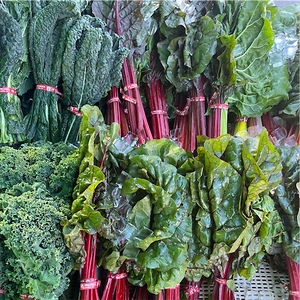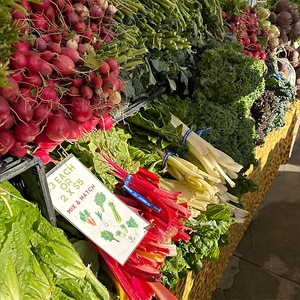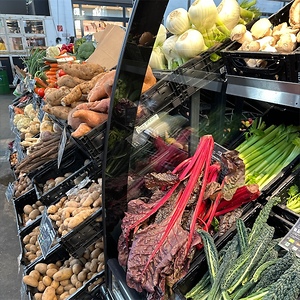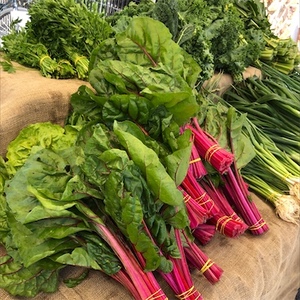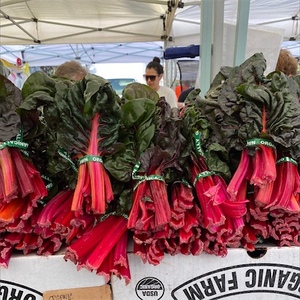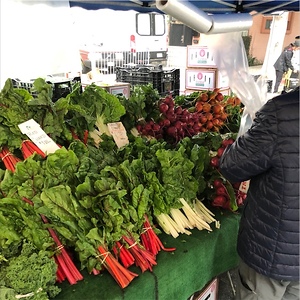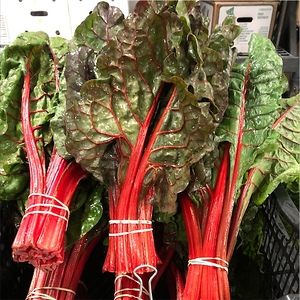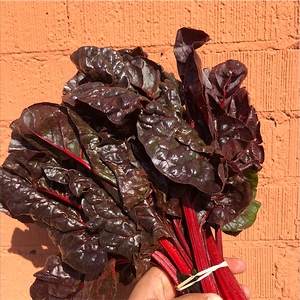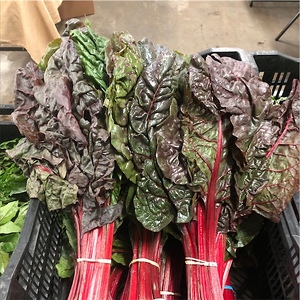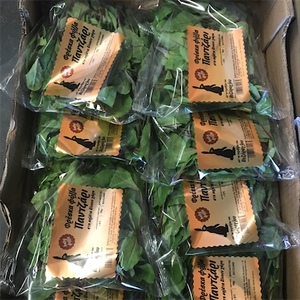


Red Swiss Chard
Estimated Inventory, 12 ct : 7.50
This item was last sold on : 07/10/25
Description/Taste
Red Swiss chard varies in size and shape, depending on the variety and maturity at harvest, and is comprised of thick, fleshy stems attached to broad, textured, and pliable leaves. The leaves are typically crinkled, semi-thick, and deeply veined, showcasing dark green and bronze hues and sometimes flushed with dark red-purple accents. The leaves are tender, crisp, and succulent when young, becoming chewier and more toothsome as they mature. The stems are thick, straight, striated, and slightly fibrous. Red Swiss chard stems range in bright red, dark red, and pink-red hues. This coloring also travels into the visible veins in the leaf’s surface. Red Swiss chard is edible raw or cooked and can be harvested at the baby and mature stages. The stems and leaves are tender when young, but at maturity, they are generally cooked to soften their consistency. Red Swiss chard has an earthy, green, mineral-forward, and subtly bitter taste. Once cooked, their bitter flavors mellow and become milder, earthy, and faintly nutty. The stems also develop a slightly sweeter, vegetal taste.
Seasons/Availability
Red Swiss chard is available year-round, with a peak season in the summer.
Current Facts
Red Swiss chard, botanically classified as Beta vulgaris subsp. cicla var. flavescens, is a general descriptor for red-stemmed chard varieties belonging to the Amaranthaceae family. Chard has been grown as a culinary ingredient throughout history and is favored for its hardiness, nutritional properties, and ornamental nature. There are many types of Swiss chard grown worldwide, found in varying colors, and Red Swiss chard is also simply known as Chard and Red Chard. It is important to note that the terms Swiss Chard and Chard are interchangeable, and Swiss was developed in the 19th century to distinguish the dark leafy greens from French spinach in seed catalogs. Popular varieties of Red Swiss chard include Vulcan, Ruby Red, Rhubarb Supreme, Charbell, Red Magic, and Firebird. Red Swiss chard is cultivated as a commercial crop and is also grown in home gardens. The plants are valued for their ability to be harvested throughout the season, and exterior leaves can be individually removed for culinary purposes, keeping the rest of the greens intact to continue to grow. Chefs and home cooks seek Red Swiss chard for its versatility, and both stems and leaves are incorporated into a wide array of fresh and cooked culinary preparations.
Nutritional Value
Red Swiss chard has not been extensively studied for its nutritional properties separate from the other chard types. Swiss chard, in general, is known for containing minerals like magnesium, iron, phosphorus, calcium, copper, zinc, and manganese. Magnesium controls nerve functions, iron develops the protein hemoglobin for oxygen transport through the bloodstream, while calcium and phosphorus support bones and teeth. Copper helps the body develop connective tissues, zinc contributes to regulating thyroid hormone levels, and manganese assists with wound healing. Swiss chard also provides vitamins A, C, E, and K to maintain healthy organs, strengthen the immune system, and guard the cells against the damage caused by free radicals. Beyond vitamins and minerals, some types of Swiss chard contain betalains, natural pigments that give the stems their red coloring. Betalains contain antioxidant properties to reduce inflammation and protect overall bodily health.
Applications
Red Swiss chard has an earthy, bitter, and mineral-forward flavor suited for fresh and cooked preparations. Most varieties of Red Swiss chard can be used in recipes calling for chard in general. When the plants are young, their tender nature allows them to be tossed into salads. The greens can also be shredded and added to grain bowls, stuffed into sandwiches, or finely chopped into dips. Mature Red Swiss chard greens typically have a tougher texture, and the stems and greens should be separated as they have different cooking times. Chard leaves can be stripped from the stems by hand, and the stems generally take longer to cook than the greens. Red Swiss chard is popularly chopped and cooked into egg-based dishes, rice, and casseroles. They are also simmered into soups and stews, tossed into pasta dishes, or cooked as a simple side to roasted meats. Try steaming larger chard leaves and using them as wraps. They are also braised with aromatics and combined with other dark leafy greens like turnip leaves, spinach, and collards. Red Swiss chard pairs well with spices such as cumin, cardamom, turmeric, and sumac, aromatics including garlic, shallots, and onions, and meats like pork, poultry, and beef. Red Swiss chard leaves and stems should be separated for storage. The leaves can be wrapped in paper towels and, if stored properly, can stay for up to one week. Swiss chard can also be blanched and frozen for extended use.
Ethnic/Cultural Info
Swiss chard is traditionally incorporated into torta pasqualina, a famous savory dish comprising greens, cheeses, and eggs in a flaky dough served for Easter celebrations in Italy. The name torta pasqualina roughly translates from Italian to mean “Easter cake or pie” and is thought to have origins in the Liguria region in Northwest Italy. The exact date of when the recipe was created is unknown, but some sources trace the dish back to either the 14th or 16th centuries. Torta pasqualina arose during times of poverty when much of the Ligurian population relied on locally grown ingredients. It is believed that chard was a common, low-cost crop found in Italy and was frequently used in everyday and celebratory dishes. Ligurian residents also grew small quantities of wheat, allowing them to make thin pastry dough, inspiring the foundation of torta pasqualina. There are many superstitions around preparing torta Pasqualina for Easter meals, and one of the most prevalent is making the thin dough into 33 layers to represent the number of years Christ resided on the Earth. Torta Pasqualina is notably served on Easter Monday and can be prepared hot or cold.
Geography/History
Swiss chard is a descendant of the wild sea beet, an ancient plant native to coastal regions of Europe, the Middle East, and Northern Africa. Wild sea beets were selected by early civilizations for domestication over time, and as they were bred for specific traits, new variations of the plant developed, creating the first types of chard. Early versions of chard were spread throughout the Mediterranean and were believed to have been grown in civilizations, including Ancient Rome and Greece. Chard was later introduced to regions across other regions of Asia and Europe, and the edible greens were noted in English writings by the late 16th and early 17th centuries. Red Swiss chard is a term used for many varieties that showcase a red coloring and are not distinguished from other colored chards in general history. Today, Red Swiss chard varieties are commercially produced and grown in home gardens in temperate regions worldwide. The colorful stems and leaves are sold through farmers’ markets, supermarkets, and select wholesalers.
Featured Restaurants
Restaurants currently purchasing this product as an ingredient for their menu.
| UCSD Food & Nutrition Department La Jolla | San Diego CA | 858-761-1269 |
| Harvest Kitchen | Vista CA | 619-709-0938 |
| Crust Pizzeria Carlsbad 2019 | Carlsbad CA | 760-944-1111 |
| Lodge at Torrey Pines Grill | San Diego CA | 858-453-4420 |
| The Kitchen at MCASD | La Jolla CA | 619-880-8719 |
| Glenbrook Health Center | Carlsbad CA | 760-704-1000 |
| Piatti | San Diego CA | 858-454-1589 |
| The Plot Restaurant (Costa Mesa) | Costa Mesa CA | 714-852-3181 |
| The Glen at Scripps Ranch | San Diego CA | 858-444-8500 |
Recipe Ideas
Recipes that include Red Swiss Chard. One



